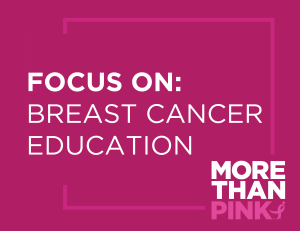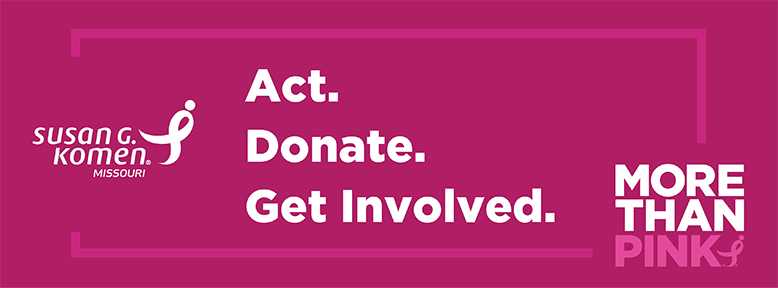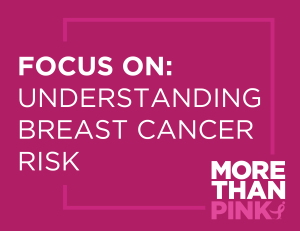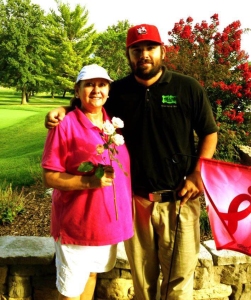 Family history and some inherited genetic mutations affect breast cancer risk in both men and women. Having an immediate family member (a parent, sibling or child) with a history of breast cancer increases your own risk of breast cancer.
Family history and some inherited genetic mutations affect breast cancer risk in both men and women. Having an immediate family member (a parent, sibling or child) with a history of breast cancer increases your own risk of breast cancer.
You should know, however, that genetic mutations linked to breast cancer are rare in the general population. Not all men and women with a family history of breast cancer are likely to have a known genetic mutation. Inherited gene mutations account for only 5 to 10 percent of all breast cancers diagnosed in the U.S.
Mutations are changes in the genetic code of a gene that affect its function. Inherited gene mutations can be passed on from a parent to a child. Some inherited gene mutations increase breast cancer risk.
Genetic testing gives people the chance to learn if they carry a gene mutation that increases their risk of developing breast cancer.
BRCA1 and BRCA2 (BReast CAncer genes 1 and 2) are the most well-known genes linked to breast cancer.
People who have a BRCA1/2 mutation have an increased risk of breast cancer and (for women) ovarian cancer. Although genetic testing for BRCA1/2 is widely advertised, testing is only recommended for certain people, including those with:
- A known BRCA1/2 gene mutation (or other inherited gene mutation linked to breast cancer) in the family
- A personal history of breast cancer at age 50 or younger
- A personal history of breast cancer at any age and a family member (parent, sibling, child, grandparent, grandchild, uncle, aunt, nephew, niece or first cousin) diagnosed with breast cancer at age 50 or younger
- A personal history of breast cancer and Ashkenazi Jewish heritage
- A personal history of triple negative breast cancer (breast cancer that is estrogen receptor-negative, progesterone receptor-negative and HER2-negative) diagnosed at age 60 or younger
- A personal or family history of ovarian cancer
- A personal or family history of male breast cancer
A family member (parent, sibling, child, grandparent, grandchild, uncle, aunt, nephew or niece) diagnosed with breast cancer at age 45 or younger
There is only a very small chance that your family carries a BRCA1/2 mutation if:
- You or an immediate family member is the only person in your family with breast cancer
- The breast cancers in your family all occurred at older ages
In most cases, genetic testing is not recommended when there is a low chance of finding a mutation.
Remember that most breast cancers are not due to a BRCA1/2 mutation. Although BRCA1/2 gene mutation testing is a simple blood test, the risks and benefits should be considered before testing. There are potential physical, emotional and financial impacts of knowing your genetic status. Thus, testing for the BRCA1/2 mutation is recommended only for people who fall into one of the categories listed above.
Genetic counseling and BRCA1/2 testing
Genetic counselors
It is strongly recommended that you speak with a genetic counselor (or other health care professional trained in genetic counseling) before deciding whether to be tested for a BRCA1/2 or other gene mutation. Only people who meet the criteria above should consider testing. A genetic counselor can help you determine whether you meet these criteria. He or she can also discuss the benefits and risks of testing (more on these issues) with you.
For more information on genetic counseling, visit the National Cancer Institute’s website (or call its hotline at 1-800-4-CANCER) or the National Society of Genetic Counselors’ website.
A doctor or genetic counselor can help you decide whether genetic testing is appropriate for you or your family members. For more information on genetic counseling, visit the National Cancer Institute’s website (or call its hotline at 1-800-4-CANCER) or visit the National Society of Genetic Counselors’ website.
For more information on inherited gene mutations, visit: http://ww5.komen.org/BreastCancer/GeneMutationsampGeneticTesting.html
Learn more: http://ww5.komen.org/uploadedFiles/_Komen/Content/About_Breast_Cancer/Tools_and_Resources/Fact_Sheets_and_Breast_Self_Awareness_Cards/Genetics%20and%20Breast%20Cancer.pdf
Hereditary breast cancer: http://ww5.komen.org/uploadedFiles/_Komen/Content/What_We_Do/We_Fund_Research/Your_Research_Dollars_at_Work/2015%20Research%20Fast%20Facts%20-%20Hereditary%20Breast%20Cancer.pdf

 In the past, many women used menopausal hormone therapy (MHT), also known as hormone replacement therapy, to relieve hot flashes and other symptoms of menopause. But studies show that use of estrogen plus progestin increases the risk of both developing and dying from breast cancer. Although MHT is approved for the short-term relief of menopausal symptoms, the U.S. Food and Drug Administration (FDA) recommends women use only the lowest dose that eases symptoms for the shortest time needed.
In the past, many women used menopausal hormone therapy (MHT), also known as hormone replacement therapy, to relieve hot flashes and other symptoms of menopause. But studies show that use of estrogen plus progestin increases the risk of both developing and dying from breast cancer. Although MHT is approved for the short-term relief of menopausal symptoms, the U.S. Food and Drug Administration (FDA) recommends women use only the lowest dose that eases symptoms for the shortest time needed. Not all breast cancers are the same. A biopsy is a test that removes cells or tissue from the suspicious area of the breast. It is needed in order to diagnose breast cancer. Once biopsied, cells are sent to a lab for a pathology report. The following information will usually be available on this report if the cells studied are cancerous:
Not all breast cancers are the same. A biopsy is a test that removes cells or tissue from the suspicious area of the breast. It is needed in order to diagnose breast cancer. Once biopsied, cells are sent to a lab for a pathology report. The following information will usually be available on this report if the cells studied are cancerous: Josh Brady’s team has participated in the Komen Mid-Missouri Race for the Cure since the event’s inaugural year, 2010, the first year after his mom was diagnosed with breast cancer.
Josh Brady’s team has participated in the Komen Mid-Missouri Race for the Cure since the event’s inaugural year, 2010, the first year after his mom was diagnosed with breast cancer. Participating in the Komen Mid-Missouri Race for the Cure is so important to the Bradys that Josh has overlooked his own pain in order to be there. “I had a bad motorcycle accident in June 2013. Up to that point, I hadn’t missed a Race.” After knee surgery that August, his only goal was to make it to and through the Race. “As painful as it was, I did make it all the way to the finish line.”
Participating in the Komen Mid-Missouri Race for the Cure is so important to the Bradys that Josh has overlooked his own pain in order to be there. “I had a bad motorcycle accident in June 2013. Up to that point, I hadn’t missed a Race.” After knee surgery that August, his only goal was to make it to and through the Race. “As painful as it was, I did make it all the way to the finish line.” The Bradys don’t have to do much to convince people to join their Komen Mid-Missouri Race Team. Their coworkers and employees know how much this fundraiser means to Josh and his family. Even customers and friends outside of the company are participating on the Brady Glass Team.
The Bradys don’t have to do much to convince people to join their Komen Mid-Missouri Race Team. Their coworkers and employees know how much this fundraiser means to Josh and his family. Even customers and friends outside of the company are participating on the Brady Glass Team.